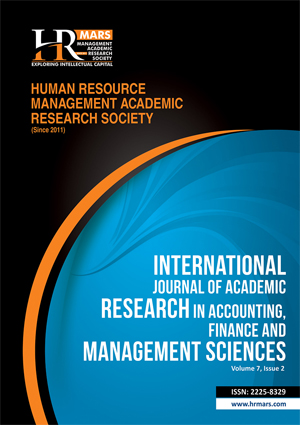
ISSN: 2225-8329
Open access
The rise in online financial scams has raised concerns and highlighted the need for a deeper comprehension of the factors contributing to victimization. This research examines the financial literacy levels among victims and investigates how financial literacy influences the likelihood of falling prey to online financial scams. Data was collected through in-depth interviews with fourteen (14) police officers from Jabatan Siasatan Jenayah Komersial Bukit Aman, who have encountered cases of financial scams and supported by the document analysis involving Police Report. Thematic analysis utilizing Nvivo 12 software was employed to analyze the data. Surprisingly, the study reveals that victims exhibit different levels of financial literacy among the victims which influence the susceptibility to online financial scams. Moreover, the findings able to explore common types of financial scams in Malaysia. Moreover, the study identifies awareness campaigns as a key measure in combating online financial scams. The findings emphasize the importance of financial literacy in determining susceptibility to online scams and provide valuable insights for policymakers, regulators, and enforcement agencies tackling this pervasive issue.
Abbott, J., & McGrath, S. A. (2016). The effect of victimization severity on perceived risk of victimization: Analyses using an international sample. Victims & Offenders, 12(4), 587–609. https://doi.org/10.1080/15564886.2016.1208130
Alam, M. K. (2020). A systematic qualitative case study: Questions, data collection, NVivo analysis and saturation. Qualitative Research in Organizations and Management: An International Journal, 16(1). https://doi.org/10.1108/QROM-09-2019-1825
Aziz, N., & Kassim, S. (2020). Does financial literacy really matter for Malaysians? A review. Advanced International Journal of Banking, Accounting and Finance, 2, 13–20. https://doi.org/10.35631/AIJBAF.22002
Chariri, A., Sektiyani, W., Nurlina, N., & Wulandari, R. W. (2018). Individual characteristics, financial literacy and ability in detecting investment scams. Jurnal Akuntansi Dan Auditing, 15(1), 91–114.
Clarke, V., & Braun, V. (2013). Successful qualitative research: A practical guide for beginners.
Engels, C., Kumar, K., & Philip, D. (2019). Financial literacy and fraud detection. SSRN Electronic Journal. https://doi.org/10.2139/ssrn.3308537
Flick, U. (2018). An introduction to qualitative research. Sage.
Gathergood, J., & Weber, J. (2017). Financial literacy, present bias and alternative mortgage products. Journal of Banking & Finance, 78, 58–83. https://doi.org/10.1016/j.jbankfin.2017.01.022
Gibbs, G. (2002). Qualitative data analysis: Explorations with NVivo. Open University.
Guest, G., Bunce, A., & Johnson, L. (2006). How many interviews are enough? An experiment with data saturation and variability. Field Methods, 18(1), 59–82. https://doi.org/10.1177/1525822X05279903
Hanus, B., & Wu, Y. (2016). Impact of users' security awareness on desktop security behavior: A protection motivation theory perspective. Information Systems Management, 33, 2–16. https://doi.org/10.1080/10580530.2015.1117842
Holtfreter, K., Reisig, M. D., & Pratt, T. C. (2008). Low self-control, routine activities, and fraud victimization. Criminology, 46(1), 189–220. https://doi.org/10.1111/j.1745-9125.2008.00101.x
Huston, S. J. (2010). The concept and measurement of financial literacy: Preliminary results from a new survey on financial literacy assessment. Conference Presentation, Academy of Financial Services Annual Conference, Anaheim, CA, October 9.
James, B. D., Boyle, P. A., & Bennett, D. A. (2014). Susceptibility to scams scale. PsycTESTS Dataset. https://doi.org/10.1037/t62359-000
Kumar, V. V., & Kumar, J. S. (2023). Insights on financial literacy: A bibliometric analysis. Managerial Finance, 49(7), 1169–1201. https://doi.org/10.1108/mf-08-2022-0371
Kvale, S., & Brinkmann, S. (2009). Interviews: Learning the craft of qualitative research interviewing (2nd ed.). Sage Publications, Inc.
Lusardi, A., & Mitchell, O. (2007). Financial literacy and retirement preparedness: Evidence and implications for financial education. Business Economics, 35–44.
Mahadin, M. U. (2021). Malaysia demographic statistics first quarter 2021. Department of Statistics Malaysia. https://www.dosm.gov.my/v1/index.php
Merriam, S. B., & Tisdell, E. J. (2016). Qualitative research: A guide to design and implementation (4th ed.). Jossey Bass.
Mohamad, R. K., Osman, Z., Ismail, Z., & Mohamad, L. (2024). Exploring Gender’s True Impact on Financial Management Behaviour. International Journal of Academic Research in Accounting Finance and Management Sciences, 14(3). https://doi.org/10.6007/ijarafms/v14-i3/22273
MyCert. (2024). Reported incidents based on General Incidents Classification Statistics 2023. https://www.mycert.org.my/portal/statistics?id=b75e037d-6ee3-4d11-8169-66677d694932
OECD. (2024). PISA 2022 results (Volume IV). https://www.oecd-ilibrary.org
Sabri, M. F., & Zakaria, N. F. (2015). The influence of financial literacy, money attitude, financial strain and financial capability on young employees’ financial well-being. Pertanika Journal of Social Sciences and Humanities, 23(4).
Salleh, M. B. (2022, August 5). PDRM: Over RM5.2 billion lost to scams in two years. The Edge Malaysia. Retrieved October 30, 2024, from https://theedgemalaysia.com/article/pdrm-over-rm52-billion-lost-scams-two-years
Savin-Baden, M., & Howell Major, C. (2013). Qualitative Research: The Essential Guide to Theory and Practice (1st ed.). Routledge. https://doi.org/10.4324/9781003377986
Statista. (2023). Share of internet users who use online banking Malaysia 2022. https://www.statista.com/statistics/788561/share-of-internet-users-who-use-online-banking-malaysia/
Strauss, A. L. (1987) Qualitative Analysis for Social Scientists. Cambridge University Press, New York. http://dx.doi.org/10.1017/CBO9780511557842
Sukumaran, K. (2015). Financial literacy -- Concept and practice. DAWN: Journal for Contemporary Research in Management, 59–65.
Venkatesan, T., & Venkataraman, R. (2018). Analysis of factors determining financial literacy using structural equation modelling. SDMIMD Journal of Management, 9(1), 19–29.
Vijay Kumar, V. M., & Senthil Kumar, J. P. (2023). Insights on financial literacy: A bibliometric analysis. Managerial Finance, 49(7), 1169–1201.
Wilson, S., Hassan, N. A., Khor, K. K., Sinnappan, S., Abu Bakar, A. R., & Tan, S. A. (2024). A holistic qualitative exploration on the perception of scams, scam techniques and effectiveness of anti-scam campaigns in Malaysia. Journal of Financial Crime, 31(5), 1140–1155. https://doi.org/10.1108/JFC-06-2023-0151
Yin, A. C. P. (2022, September 19). Securities Commission: 25% increase in reports of investment scams during COVID-19. RinggitPlus. https://ringgitplus.com
Youn, S. (2009). Determinants of online privacy concern and its influence on privacy protection behaviors among young adolescents. Journal of Consumer Affairs, 43(3), 389–418. https://doi.org/10.1111/j.1745-6606.2009.01146.x
Basir, M. A. Q. A., Yahya, M. H. D. H., Mustaffa, H., & Soh, W. N. (2024). The Impact of Financial Literacy on Online Financial Scam Victimization. International Journal of Academic Research in Accounting, Finance and Management Sciences, 14(4), 1441–1459.
Copyright: © 2024 The Author(s)
Published by HRMARS (www.hrmars.com)
This article is published under the Creative Commons Attribution (CC BY 4.0) license. Anyone may reproduce, distribute, translate and create derivative works of this article (for both commercial and non-commercial purposes), subject to full attribution to the original publication and authors. The full terms of this license may be seen at: http://creativecommons.org/licences/by/4.0/legalcode